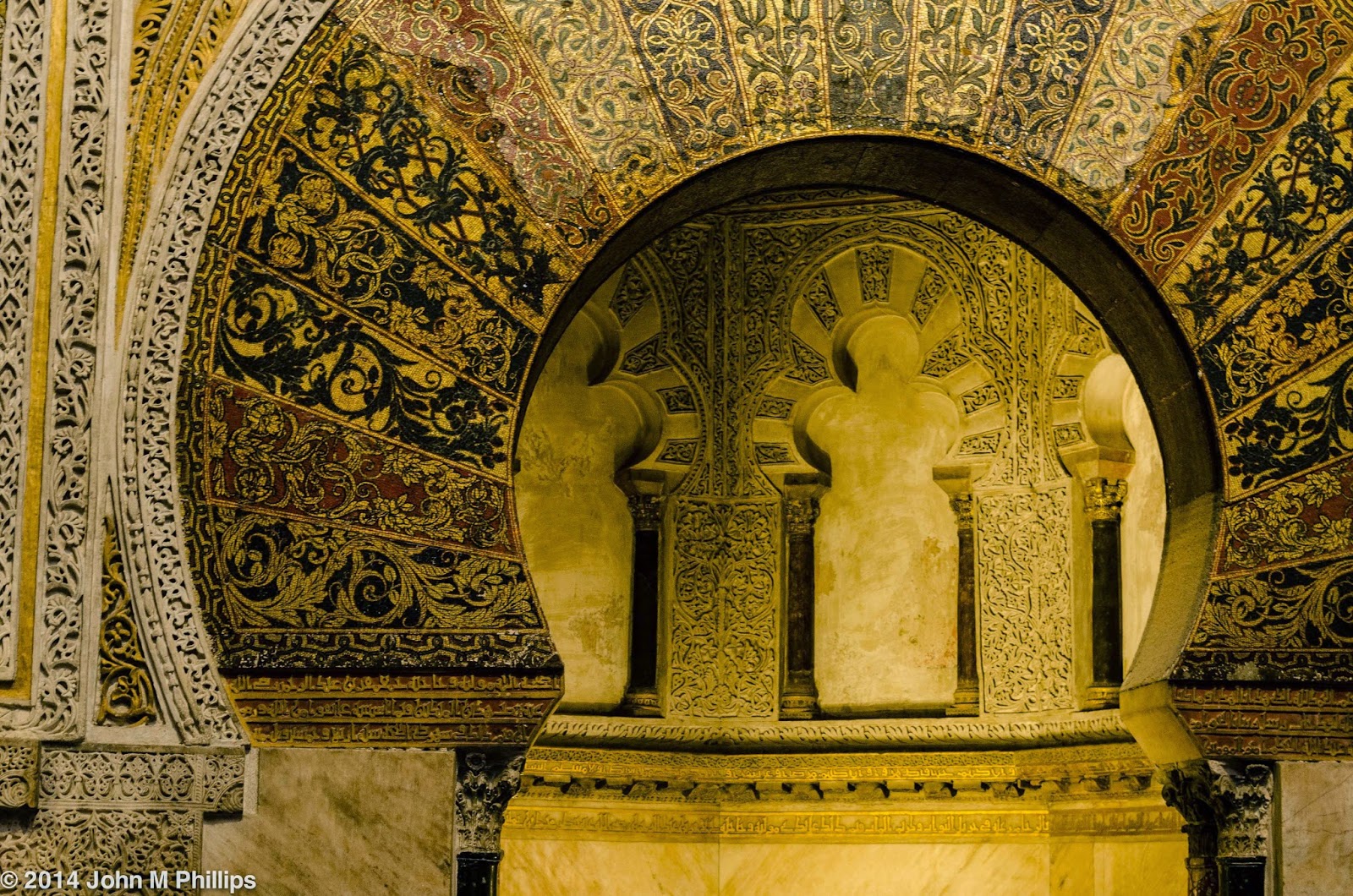Of the three major Arabic monuments in Andalusia that we visited on our tour, the Alcazar, the Mezquita, and the Alhambra, my favorite was the Mezquita in Cordoba. Its architecture is stunning; the history of its construction is particularly fascinating; and it proved to be the most accessible from a photographic point of view, both inside and out.
The Mezquita, which means "mosque" in Spanish, was built by the Moors in the late 10th century on land on which the Visigoths had earlier built a Christian church. When the Christians retook Cordoba in the 13th century, they kept most of the Mezquita intact but tore down the central mosque and erected a cathedral in its stead, right in the midst of the Mezquita structure. The combination is stunning.
Here is a first look at the Mezquita from across the river that borders the large complex. (More on this later.)
Upon entering the Mezquita, one is struck by the overwhelming number of Arabic arches built of jasper, onyx, marble, and granite of different colors, giving the arches a "candy stripe" appearance. In fact, there are some 856 such arches (although there were over 1,000 before the Christians removed a few hundred to make room for their cathedral). Although the arches are stunning, to say the least, effectively photographing them is a challenge. There were huge crowds milling about among the columns and the light was, as usual, relatively low, and at first I found myself avoiding the crowds by shooting only the upper portions of the arches. I didn't feel this was working very well, and I ultimately discarded most of those shots. Here is one that I retained to illustrate the problem.
I finally realized that I needed to "ground" the arches by showing the floor, accepting the fact of the multitude of visitors, as in the following shots.
Not all bad, as these shots, I feel, give a much better sense of space. I also took a few shots of details that I thought give a feel both for the workmanship and of the labyrinthine sense that the arches create.
Even though these shots don't include the bases of the arches, because of their detail orientation, I think they provide a glimpse of the amazing quality of the architecture in a way that is not possible with broader shots.
The Arabic equivalent of the Christian apse is the mihrab, and the Mezquita's is stunning. Normally, the mihrab is built so that when the worshippers face it for prayer they are facing in the direction of Mecca. But oddly this mihrab is built so that the worshippers are facing south rather than southeast. The crowds precluded my getting a clean shot of the mihrab, so I decided instead to incorporate the crowds.
I think this actually worked well as a silhouette shot. Here are a couple more shots of the mihrab as I worked my way to the front of the crowds.
I am still amazed at the fact that this structure was built over 1000 years ago.
Before moving on to the cathedral, I got a couple of shots that feature both Muslim and Christian influences. The first includes the Muslim arches along with what appears to be a Christian-influenced stained glass rose window.
And a second shot includes an arch that features representational, that is, Christian, art as well as the more traditional abstract Muslim arches.
Then it was on to the cathedral. Here is a first shot of the entrance to the cathedral.
Note the ornate ceiling above and behind the bas-relief of the pontiff. Moving to the other side, I was able to get a good shot of the ceiling by my technique of placing the camera on the floor pointing up. The shot's not perfect, but I was quite happy with its quality and composition, considering the conditions (massive crowds and complicated lighting).
It appears that I captured only a portion of the ceiling but note that the pediment, surmounted by a cross, that is showing at the very bottom of the image is the same pediment and cross that appear in the prior photo.
Once we were in the cathedral, there was an obvious change in terms of a dedication to representational art. Here are a few examples.
I was also fortunate to capture another of the ornate ceilings, this time in its entirety, again by setting my camera on the floor. And this time I was pretty much able to nail the center point.
There is an amazing amount of detail in the artistry of this ceiling.
Before leaving the Mezquita I got a shot of one of the skylights back in the Arabic portion that I thought acted as an interesting semi-abstract.
Finally, here are two shots of the exterior, one featuring the cathedral tower . . .
and the other of the overall Mezquita and the Roman bridge crossing the river.
I knew that I wanted to try to capture both the bridge and the Mezquita in one shot, and I posed the tree on the right to provide a foreground anchor. And I was lucky, as this is the only shot that I took. One of our fellow travelers liked the shot and "borrowed" it to make a beautiful watercolor rendition of the scene.
John






















No comments:
Post a Comment
Note: Only a member of this blog may post a comment.